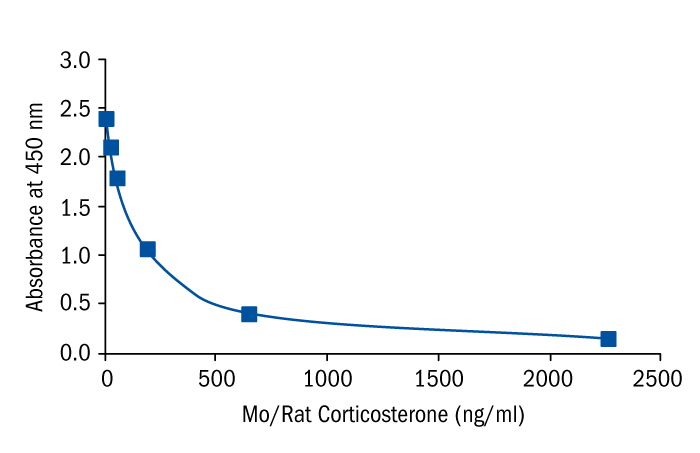Type
Competitive ELISA
Description
The BioVendor Mouse/Rat Corticosterone ELISA is a competitive immunoassay for the measurement of corticosterone in rat and mouse serum or plasma. For research use only. Not for use in diagnostic procedures.
Applications
Serum, Plasma
Sample Requirements
10 µl/well
Shipping
On blue ice packs. Upon receipt, store the product at the temperature recommended below.
Storage/Expiration
Store the complete kit at 2–8°C. Under these conditions, the kit is stable until the expiration date (see label on the box).
Calibration Curve
Calibration Range
15 – 2250 ng/ml
Limit of Detection
6.1 ng/ml
Features
- RUO
- calibration range 15-2250 ng/ml
- limit of detection 6.1 ng/ml
Research topic
Steroid hormones, Animal studies
Summary
Corticosterone is secreted by the adrenal cortex under control of the pituitary hormone ACTH via a negative feedback mechanism. It is the most abundant circulating steroid in rats, since rodents are not able to synthesize Cortisol, the major glucocorticoid in human, as a result of lacking the enzyme C17-Hydroxylase.
Corticosterone has a wide range of activities in rodents. It regulate s carbohydrate, protein and fat metabolism. It has also an influence on the hemopoietic system and reduces the total number of lymphocytes and eosinophils, but to a lesser extent than cortisol. In contrast to cortisol, corticosterone has only minimal anti-inflammatory activity.
Corticosterone level in nocturnal animals like rats exhibit a distinct circadian variation with peak values in the latter portion of the day, followed by a nadir in the morning (1) and is believed to play an important role in sleep-wake cyclus (2). This is in contrast to diurnal mammals, where peak concentrations of glucocorticoids are found in the morning. Enhanced corticosterone release by female compared to male rats under basal and stress conditions has been observed (6).
Determination of corticosterone in rats is of interest to facilities conducting neurophysiological research, to academic institutions and to pharmaceutical companies with drug research departments. Drugs that influence the endocrine system can increase or reduce corticosteroid production in the adrenal cortex. Rat serum corticosterone is therefore an ideal indicator of the side effects of a potential therapeutic agent. The same constellations of effects seen in rats are generally seen in human. Plasma corticosterone in rats is often used in connection with ACTH measurement as a stress indicator (3,4). The effects of chronic stress on the function of the hypothalamic-pituitary-adrenocortical system are age-dependent. Recent studies suggest that aging increases basal but not stress induced levels of corticosterone in the brain (5).
Find documents for the lot
Example Instructions for Use (RUO)
Example Instructions for Use (RUO)
Safety Information (RUO)
MSDS (RUO)

